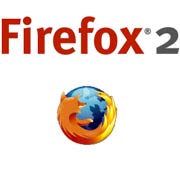
|
contents | software | |||||||
| Mozilla Firefox 2.0 vs Internet Explorer 7.0: Who Will Win?  Mozilla at last issues Firefox 2, a major update to its free, open source Web browser. Firefox is developed by an international community of contributors working together under the umbrella of the Mozilla Foundation, a non-profit, public-benefit organization dedicated to improving the Internet experience for people everywhere. In less than two years, tens of millions of people worldwide have discovered the easier, faster and safer online experience that Firefox provides. Translated into more than 35 languages at its release, Firefox 2 is available in a native language version for more people around the world than any other Web browser. Mozilla at last issues Firefox 2, a major update to its free, open source Web browser. Firefox is developed by an international community of contributors working together under the umbrella of the Mozilla Foundation, a non-profit, public-benefit organization dedicated to improving the Internet experience for people everywhere. In less than two years, tens of millions of people worldwide have discovered the easier, faster and safer online experience that Firefox provides. Translated into more than 35 languages at its release, Firefox 2 is available in a native language version for more people around the world than any other Web browser.Improvements to the user interface, security tools and options for customization, combine to deliver a rich, engaging, safer and more productive Web browsing experience for all. New Features Tabbed browsing. Firefox popularized tabbed browsing, enabling multiple Web sites to be viewed as separate tabs contained within a single browser window, and improving people's efficiency by helping them better organize their desktops. In Firefox 2, tabbed browsing has been further improved with the addition of individual close buttons on each tab, enhanced tab navigation features, and a session restore system that automatically restores previously-open windows and tabs when a new browsing session is started. Spell checking. Modern Web sites are increasingly complex with the rollout of new, rich Internet applications, such as word processors, spreadsheets and blogging tools. Inline spell checking in Firefox 2 automatically checks for spelling errors and suggests corrections as users interact with Web sites, bringing a common desktop feature to the Web. Search. Search is one of the most frequently used features of the Web. With Firefox 2, Mozilla improves the browser's integrated search capabilities, making it even easier for users to find the information they are looking for. The new Search Suggestions feature dynamically updates a drop-down list of suggested search terms as users enter text into the search bar for Google, Yahoo! or Answers.com search engines. Web feeds. Firefox users can now take better advantage of the frequently updated content offered by Web sites, with increased options for handling Web feeds. Users now see a preview of the content being offered and are given the option to subscribe to a feed as a Live Bookmark, using a Web service such as Bloglines, My Yahoo., or Google Reader, or with a desktop application. Identity theft protection. In addition to its award-winning safeguards for blocking drive-by installation of spyware and unwanted pop-up windows, Firefox 2 helps protect users from identity theft by quickly informing them when they surf to a questionable Web site. To protect users' privacy, Phishing Protection is active by default with a local blacklist that updates hourly, rather than sending information to an external online service. An enhanced mode is available where users may optionally elect to have Firefox check the validity of Web sites with a third-party Web service, such as Google, prior to loading the site. Phishing Protection provides warnings, advice and guidance when Firefox encounters a Web site that appears to be fraudulent or malicious. Proven security model. Mozilla's open and transparent community-driven security model helps ensure Firefox provides the safest possible online experience. Thousands of security experts and technical contributors from around the world examine and analyze the Firefox source code, uncover potential threats and vulnerabilities, and work together to quickly identify and address emerging threats. This open, distributed, innovative approach to security puts people's interests first and delivers the safest Web experience possible. Customization. No other browser can be customized like Firefox 2. With thousands of add-ons that enhance the browser's functionality and features, Firefox lets users personalize their Web browsers to fit their interests and style. write your comments about the article :: © 2006 Computing News :: home page |